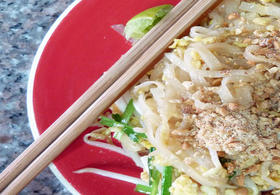In Chiang Mai, food writer Eve Turow discovered a key to regional cooking: simplicity. Her favorite recipes showcase Thai mastery of the four basic tastes (sweet, salty, bitter and sour) while letting fresh ingredients shine. At home, she re-creates the dishes she fell in love with.
Outside the old city of Chiang Mai, Thailand, the Warorot Market was bustling with activity. It was an orchestra of sizzling satay of pork and chicken livers, the singsong melody of Thai, and steaming bowls of noodle soups. Row upon row of rainbow-colored fruit and vegetable stalls glimmered in the sun. The female vendors fanned themselves and leaned in to one another, gossiping under the brims of their straw-weaved hats. I imagined them discussing their sons and daughters, the amount of food they hoped to sell, or the weather expected that afternoon.
It was my first time at a street market in Thailand. Within minutes I was perspiring, and I could see my fair Chicago winter skin beginning to turn pink. My feet were covered in dirt from the crowded road, but even so, nothing could dampen my excitement. I leaned over each stall inspecting the bounty: speckled round vegetables, a woman taking apart a jackfruit, packaged
pomelo and strawberries with chili and salt. I spent the day sampling, drinking, savoring and slurping. Every taste, it seemed, was new: The bananas were heartier, the grapes more sour, and the strawberries revealed new flavors, highlighted by the salt and chili spice.
I was lucky enough to have four weeks to learn and discover the culinary secrets and history of Thai cooking. I learned about
kao soi, a noodle curry soup from northern Thailand, and my absolute favorite — spicy papaya salad. Each dish sparkled with the juxtaposition of sweet, salt, spice and acidity. The balance was perfection, each note playing off one another on my tongue, showcasing Thai mastery of the four basic tastes: sweet, salty, bitter and sour. A spicy noodle dish is soothed by the crunch and cool of fresh bean sprouts; a hearty meat soup is lightened by a spritz of lime.
The international influence on Thai cuisine is unmistakable. The integral Chinese techniques of stir-frying and frying are regularly used. The addition of chilies is attributed to trade with the Portuguese, who became devotees of spice while in South America. Curry is adapted from India, and satay from Malaysia and Indonesia. Yet, Thai cuisine maintains a taste of its own by incorporating a bundle of fresh herbs such as tamarind, lemongrass, cilantro and basil.
I practiced Thai cooking during an afternoon course at Thai Kitchen Cookery in Chiang Mai. There, I was able to put a name to the flavors I had been experiencing. I discovered coconut sugar, a sticky beige paste made from the sap of the coconut palm with flavor resembling light brown sugar mixed with caramel. I cooked with
galangal (Thai ginger) and tasted its fragrant bite in
tom yum kung soup. We shredded green papayas for our papaya salad, using the unripened, bright green and mild-flavored fruit that beautifully absorbs the sugar, acid and spice.
Working my way through each recipe, I found myself adding similar ingredients each time: oyster sauce, fish sauce, chili, coconut sugar and lime. The elements were so basic, allowing the fresh Thai produce to shine. All of the flavors of the market come through in each dish, enhanced by the seasonings. Oyster sauce brings in a slight seafood flavor along with the salty fish sauce, but neither is used in excess.
At home in the United States, I’m often in awe of dishes conceptualized with 30 ingredients, wondering how the cook decided to put those flavors together. In Chiang Mai, though, I learned that the number of ingredients is not the key. Often, simplicity is best with fresh, unmasked ingredients.
Thai food reflects Thai life: vibrant, colorful, yet polite and easygoing. Some of the simplest experiences are best. It takes very little effort here to have a great day, or for that matter, a great meal. Copyright 2011 National Public Radio. To see more, visit
http://www.npr.org/.







